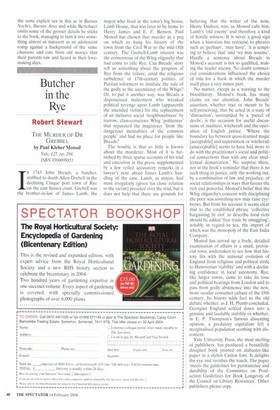Butcher in the Rye
Robert Stewart
THE MURDER OF DR GREBBEL by Paul Kleber Monod Yale, £25, pp. 294, ISBN 0300099851 In1743 John Breads, a butcher, stabbed to death Allen Grebell in the declining Cinque port town of Rye on the east Sussex coast. Grebell was the brother-in-law of James Lamb, the
mayor who lived in the town's big house, Lamb House, that was later to be home to Henry James and E. F. Benson. Paul Monod has chosen that murder as a peg on which to hang his history of the town from the Civil War to the mid-18th century. The Grebell-Lamb interest was the cornerstone of the Whig oligarchy that had come to rule Rye. Can Breads' story tell us something about the progress of Rye from the failure, amid the religious turbulence of 17th-century politics, of Puritan reformers to institute the rule of the godly to the ascendancy of the Whigs? Or, to put it another way, was Breads a dispossessed malcontent who wreaked political revenge upon Lamb (apparently the intended victim) for the replacement of an inclusive social 'neighbourliness' by narrow, class-conscious Whig 'politeness' that separated the magistracy 'from the dangerous mentalities of the common people' and had no place for people like Breads?
The trouble is that so little is known about the murderer. Most of it is furnished by three sparse accounts of his trial and execution in the press, supplemented by a few veiled accusatory remarks in a lawyer's note about James Lamb's handling of the case. Lamb, as mayor, had most irregularly (given his close relation to the victim) presided over the trial, but it does not help that there are grounds for believing that the writer of the note, Henry Dodson, was, as Monad calls him, Lamb's 'old enemy' and therefore a kind of hostile witness. It is never a good sign when a historian has recourse to phrases such as 'perhaps', 'may have', 'it is tempting to believe that' and 'we may assume'. Hardly a sentence about Breads in Monod's account is not so qualified, making the reader uneasy. No doubt commercial considerations influenced the choice of title for a book in which the murder itself plays a very minor part.
No matter, except as a warning to the bloodthirsty. Monod's book has many claims on our attention. John Breads' assertion, whether true or meant to be self-preserving, that he acted in a state of 'distraction', surrounded by a 'parcel of devils', is the occasion for useful discussions of madness, witchcraft and the operation of English justice. 'Where the boundary lay between quasi-learned magic [acceptable] and superstition or witchcraft [unacceptable] seems to have had more to do with the practitioner's social and political connections than with any clear intellectual demarcation.' No surprise there, nor at the book's reminder that there is no such thing as justice, only the working out, by a combination of law and prejudice, of social relationships in ways that favour the rich and powerful. Monod's belief that the Whig oligarchy's concern with disciplining the poor was something new may raise eyebrows. But from his account it seems clear that to the established phrase 'collective bargaining by riot' to describe food riots should be added 'free trade by smuggling', notably in regard to tea, the import of which was the monopoly of the East India Company.
Monod has served up a lively, detailed examination of affairs in a small, provincial town, undertaken to see how that history fits with the national evolution of England from religious and political strife to Hanoverian 'stability' and with a declining confidence in local autonomy. Rye, like larger towns, came to take its tone and political bearings from London and to pass from godly abstinence into the new, more secular consumer culture of the 18th century. Its history adds fuel to the old debate whether. as J. H. Plumb concluded, Georgian England settled down into a genuine and laudable stability or whether, in E. P. Thompson's famous dissenting opinion, a predatory capitalism left a marginalised population seething with discontent.
Yale University Press, the most sterling of publishers, has produced a beautifully designed book printed on alabaster-like paper in a stylish Caslon font. It delights the eye and ravishes the touch. The paper 'meets the guidelines for permanence and durability of the Committee on Production Guidelines for Book Longevity of the Council on Library Resources'. Other publishers please copy.


































































 Previous page
Previous page